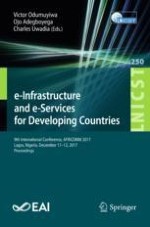2018 | Buch
e-Infrastructure and e-Services for Developing Countries
9th International Conference, AFRICOMM 2017, Lagos, Nigeria, December 11-12, 2017, Proceedings
herausgegeben von: Victor Odumuyiwa, Ojo Adegboyega, Charles Uwadia
Verlag: Springer International Publishing
Buchreihe : Lecture Notes of the Institute for Computer Sciences, Social Informatics and Telecommunications Engineering
